In a world where “Where are you?” is often answered with a quick tap on an iPhone, the accuracy of location sharing becomes a hot topic. It’s like having a personal GPS that sometimes gets a little too creative with its directions. Ever wondered if your iPhone’s idea of “nearby” is actually just a few blocks away or a whole town over?
Understanding Location Sharing on iPhone
Location sharing on iPhone employs GPS technology to pinpoint a user’s location. While this feature offers convenience, it raises questions about accuracy and reliability.
What Is Location Sharing?
Location sharing allows users to share their real-time locations with friends or family. This feature appears within various apps like Messages, Find My, and Google Maps. Users can choose to share their locations indefinitely or for a set period. Privacy settings dictate how data is shared, ensuring control over personal information. As a result, this feature serves both safety and social purposes.
How It Works on iPhone
iPhones utilize a combination of GPS, Wi-Fi signals, and cellular data to determine locations precisely. GPS provides broad coverage outdoors, capturing accurate locations within a few meters. Wi-Fi signals enhance accuracy indoors, where GPS may falter. Permissions must be granted to apps requesting location access. Users can fine-tune location settings via Privacy preferences under Settings. This ensures that location sharing operates effectively while prioritizing user security.
Factors Affecting Accuracy

Several factors influence the accuracy of location sharing on iPhones. Understanding these elements can enhance user experience.
GPS Technology
GPS technology forms the foundation of location services on iPhones. This satellite-based system computes the device’s precise position, relying on signals from multiple satellites. Accuracy can vary, enhancing to within a few meters in open spaces. However, tall buildings or natural obstructions can weaken the signals, reducing precision. Multiple satellite connections improve accuracy further. The strength of the incoming signals directly impacts performance.
Wi-Fi and Cellular Data
Wi-Fi networks assist in refining location accuracy significantly. When connected to a Wi-Fi network, the iPhone uses identifiable information from nearby routers to estimate its location. This method proves particularly effective in urban settings where GPS signals may struggle. Cellular data provides another layer of support, utilizing nearby cell towers to triangulate position. Both these sources work in conjunction with GPS technology, allowing for more precise location sharing, especially indoors.
Environmental Influences
Environmental conditions also affect accuracy. Urban areas might introduce interference from buildings and other structures. Natural elements like trees or mountains can limit signal strength as well. Weather conditions, such as heavy rain or fog, may hinder satellite communication, impacting location accuracy. Moreover, indoor environments often present challenges, where GPS signals weaken considerably. Smartphone placement can influence signal strength as well, impacting overall location reliability.
User Experiences and Feedback
Users frequently share varied experiences regarding iPhone location sharing. The feedback often highlights both positive and negative aspects.
Positive Experiences
Many users find location sharing on iPhone reliable, particularly when meeting friends. Families appreciate the ability to track loved ones during outings, enhancing safety during travel. Several users mention that real-time updates in apps like Find My increase peace of mind when children are out. Accurate GPS signals frequently help when navigating unfamiliar areas. The integration with Wi-Fi strengthens location precision, especially in bustling urban environments. Users enjoy the customizable privacy settings, allowing them to choose who sees their location. Features that allow temporary location sharing during specific events resonate well with those who value control over their information.
Negative Experiences
Some users report frustration with inaccuracies in location sharing. Instances of incorrect positioning lead to confusion when trying to coordinate meetups. Poor signal strength in densely populated areas often results in substantial delays in updates. Environmental factors like tall buildings and heavy foliage can inhibit GPS accuracy, causing users to feel unreliable. Issues with battery drain arise when continuous location services remain enabled. Users also express concerns about privacy, fearing unwanted tracking when sharing location with apps. Inconsistent performance across different devices may discourage individuals from using location sharing features.
Privacy Considerations
Privacy remains a key factor when sharing location on an iPhone. Users must understand how their location data is handled and shared.
Data Security
Data security is essential for maintaining user trust. Apple employs encryption measures to safeguard location information during transmission. This practice ensures that unauthorized access to location data remains minimal. Additionally, stored location data receives protection through secure protocols. By regularly updating privacy policies, Apple reinforces its commitment to user security. Regular audits help to identify and mitigate potential vulnerabilities, ensuring that sensitive information stays confidential.
User Control and Settings
User control over privacy settings plays a significant role in location sharing. iPhone owners can manage who accesses their location data through system settings. Users can choose to share their location with select contacts and hide it from others. Users also receive options to limit location access to specific apps and timeframes. Such flexibility enables individuals to maintain desired privacy levels. Frequent alerts remind users to review app permissions, enhancing awareness about privacy. Empowering users with these controls fosters confidence in the iPhone’s location-sharing capabilities.
Conclusion
Location sharing on iPhones offers a blend of convenience and challenges. While the integration of GPS, Wi-Fi, and cellular data enhances accuracy in many situations, factors like environmental conditions and user settings can impact performance. Users appreciate the ability to manage privacy and customize sharing options, providing a sense of control over their location data. Despite occasional inaccuracies and concerns about battery life, many find the service reliable for staying connected with friends and family. Understanding these nuances can empower users to make informed decisions about their location-sharing practices.


